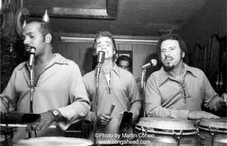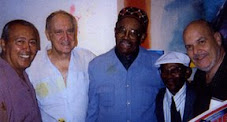
One matinee at
La Conga, a short, good-looking 17-year-old was seen cutting his way through the tables. He was carrying something half hidden on his way to the rear of the bandstand. He did this without disturbing the moment, which happened to be a romantic “
precioso bolero.” No doubt he had come, not to sit in with the band, but to practice his bongos with
Noro’s approval. He sat off the bandstand in a corner. It was the first time I heard someone say, “
Tito Puente.”
The next time I saw him was at the Papagallo Bar at the Avila Hotel in Caracas. He played the carnival every year. We spoke of the Billo Boys and Venezuela’s growing musical influence. The third time was at the St. Regis Hotel bar. He was kind enough to greet me and my lady friend. Having Tito Puente embrace you in front of your date is indeed a cool occurrence, a fortuitous happenstance. The fourth time was at the Boys Harbor in El Barrio. He was on his way to give percussion lessons to the neighborhood kids with his manager, Joe Conzo. I complained to them that contributions to the Tito Puente Scholarship Fund were not going exclusively to Puerto Rican youngsters as I had been led to believe would be the case.
Last time I saw him, he was lying in state. He had risen to join the family of music’s historic nobility. From the silent, darkened chapel, I walked out into the sunshine. Looking up at the sky, there he was with his sticks, jamming “Ran Kan Kan,” segueing into “Mambo Diablo.”
I went to a bar across the street, where I ordered two añejos, one for Tito and one for myself.
 One matinee at La Conga, a short, good-looking 17-year-old was seen cutting his way through the tables. He was carrying something half hidden on his way to the rear of the bandstand. He did this without disturbing the moment, which happened to be a romantic “precioso bolero.” No doubt he had come, not to sit in with the band, but to practice his bongos with Noro’s approval. He sat off the bandstand in a corner. It was the first time I heard someone say, “Tito Puente.”
One matinee at La Conga, a short, good-looking 17-year-old was seen cutting his way through the tables. He was carrying something half hidden on his way to the rear of the bandstand. He did this without disturbing the moment, which happened to be a romantic “precioso bolero.” No doubt he had come, not to sit in with the band, but to practice his bongos with Noro’s approval. He sat off the bandstand in a corner. It was the first time I heard someone say, “Tito Puente.” 

1 comment:
Hi Vincent Livelli!
My name is Heather Lee and I'd love to talk to you about music entertainment in New York during the 1930s and 1940s. I am mounting an exhibit this October on food and entertainment.
Thanks,
Heather
Post a Comment